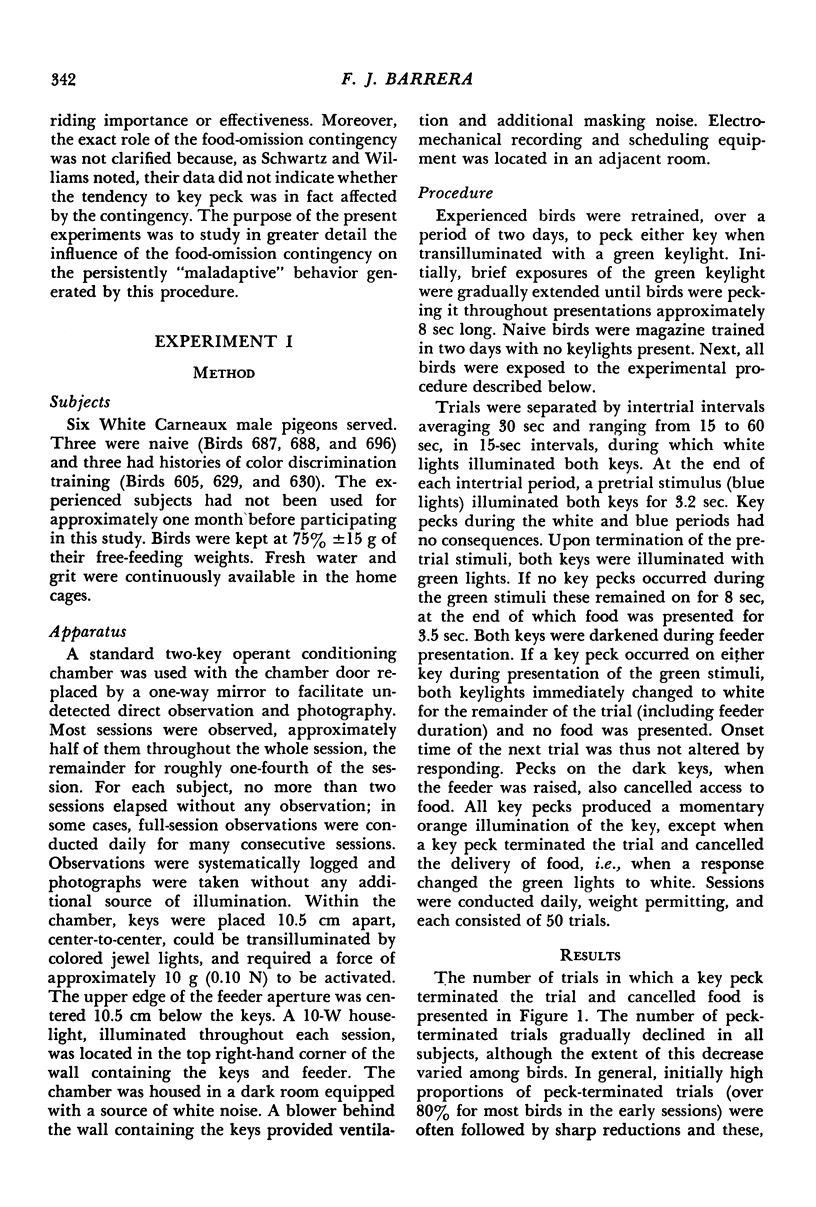Abstract
Pigeons were exposed to a schedule of stimulus-correlated food presentations. When key pecks terminated trial signals and cancelled the delivery of food, pecking was either gradually or rapidly redirected away from the keys, depending on whether the food-omission contingency was introduced from the outset or after exposure to a response-independent baseline. In all cases, the food-omission contingency substantially reduced or eliminated pecking at the keys.
Full text
PDF














Selected References
These references are in PubMed. This may not be the complete list of references from this article.
- Bachrach A. J. A simple method of obtaining a scatter distribution of off-key pigeon pecking. J Exp Anal Behav. 1966 Mar;9(2):152–152. doi: 10.1901/jeab.1966.9-152. [DOI] [PMC free article] [PubMed] [Google Scholar]
- Brown P. L., Jenkins H. M. Auto-shaping of the pigeon's key-peck. J Exp Anal Behav. 1968 Jan;11(1):1–8. doi: 10.1901/jeab.1968.11-1. [DOI] [PMC free article] [PubMed] [Google Scholar]
- Dunham P. J., Mariner A., Adams H. Enhancement of off-key pecking by on-key punishment. J Exp Anal Behav. 1969 Sep;12(5):789–797. doi: 10.1901/jeab.1969.12-789. [DOI] [PMC free article] [PubMed] [Google Scholar]
- HEARST E. ESCAPE FROM A STIMULUS ASSOCIATED WITH BOTH REWARD AND PUNISHMENT. J Comp Physiol Psychol. 1963 Dec;56:1027–1031. doi: 10.1037/h0046565. [DOI] [PubMed] [Google Scholar]
- HEARST E., KORESKO M. B. SELF-PRESENTATION AND SELF-TERMINATION OF A CONFLICT-PRODUCING STIMULUS. Science. 1964 Oct 16;146(3642):415–416. doi: 10.1126/science.146.3642.415. [DOI] [PubMed] [Google Scholar]
- Herrnstein R. J., Loveland D. H. Food-avoidance in hungry pigeons, and other perplexities. J Exp Anal Behav. 1972 Nov;18(3):369–383. doi: 10.1901/jeab.1972.18-369. [DOI] [PMC free article] [PubMed] [Google Scholar]
- Hoffman H. S., Stratton J. W., Newby V. Punishment by response-contingent withdrawal of an imprinted stimulus. Science. 1969 Feb 14;163(3868):702–704. doi: 10.1126/science.163.3868.702. [DOI] [PubMed] [Google Scholar]
- Peterson G. B., Ackilt J. E., Frommer G. P., Hearst E. S. Conditioned Approach and Contact Behavior toward Signals for Food or Brain-Stimulation Reinforcement. Science. 1972 Sep 15;177(4053):1009–1011. doi: 10.1126/science.177.4053.1009. [DOI] [PubMed] [Google Scholar]
- Schwartz B., Williams D. R. The role of the response-reinforcer contingency in negative automaintenance. J Exp Anal Behav. 1972 May;17(3):351–357. doi: 10.1901/jeab.1972.17-351. [DOI] [PMC free article] [PubMed] [Google Scholar]
- Schwartz B., Williams D. R. Two different kinds of key peck in the pigeon: some properties of responses maintained by negative and positive response-reinforcer contingencies. J Exp Anal Behav. 1972 Sep;18(2):201–216. doi: 10.1901/jeab.1972.18-201. [DOI] [PMC free article] [PubMed] [Google Scholar]
- Valenstein E. S., Cox V. C., Kakolewski J. W. Reexamination of the role of the hypothalamus in motivation. Psychol Rev. 1970 Jan;77(1):16–31. doi: 10.1037/h0028581. [DOI] [PubMed] [Google Scholar]
- Wessells M. G. The effects of reinforcement upon the prepecking behaviors of pigeons in the autoshaping experiment. J Exp Anal Behav. 1974 Jan;21(1):125–144. doi: 10.1901/jeab.1974.21-125. [DOI] [PMC free article] [PubMed] [Google Scholar]
- Williams D. R., Williams H. Auto-maintenance in the pigeon: sustained pecking despite contingent non-reinforcement. J Exp Anal Behav. 1969 Jul;12(4):511–520. doi: 10.1901/jeab.1969.12-511. [DOI] [PMC free article] [PubMed] [Google Scholar]


